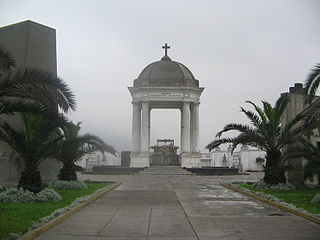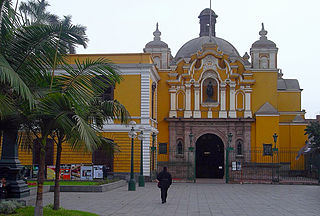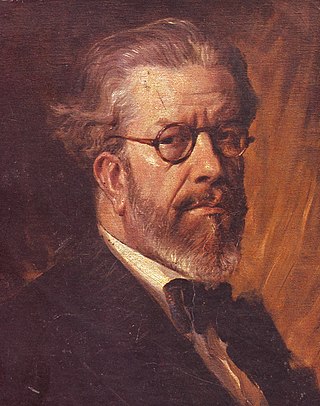
The National University of San Marcos is a public research university located in Lima, the capital of Peru. It is considered the most important, recognized and representative educational institution at the national level. At the continental level, it is the first officially established and the oldest continuously operating university in the Americas, which is why it appears in official documents and publications as "University of Peru, Dean University of the Americas".
The term Peruvian literature not only refers to literature produced in the independent Republic of Peru, but also to literature produced in the Viceroyalty of Peru during the country's colonial period, and to oral artistic forms created by diverse ethnic groups that existed in the area during the prehispanic period, such as the Quechua, the Aymara and the Chanka South American native groups.

Presbyter Matías Maestro Cemetery, formerly the General Cemetery of Lima, is a cemetery, museum and historical monument located in the Barrios Altos neighbourhood of Lima District, in Lima, Peru. Inaugurated on May 31, 1808, it was the first pantheon in the city since burials were previously held in the city's churches. It was named in honour of its designer, Spanish priest Matías Maestro.
The Constituent Congress of Peru, 1822 was the first democratically elected institution in Peru. Its members, called deputies, were appointed by popular election called by the liberator José de San Martín, who then exercised power as Protector of Peru. The main task of this meeting was to give the Republic of Peru its first constitution, which was the liberal constitution of 1823. Also, before the retirement of San Martín, presented the Executive to three members, who formed a collegial body called the Supreme Governing Junta and whose head was General José de la Mar. subsequently ratified in succession to the former presidents of the Republic of Peru: José de la Riva Agüero and José Bernardo de Tagle.

The Seminary of Saint Turibius, also known as the Seminary of Lima or, is a priestly seminary in charge of training seminarians to be future priests of the Roman Catholic Archdiocese of Lima. It is based in Lima, Peru, and is the second oldest seminary in the Americas after that of Bogotá, having been founded on December 7, 1591, by then Archbishop Turibius of Mongrovejo.

The Panteón de los Próceres is a crypt inside the old Church of the Real Convictorio de San Carlos that holds the remains of the heroes of the Peruvian War of Independence.

The Plaza San Martín is one of the most representative public spaces of the city of Lima, Peru. It is located at the ninth block of Colmena avenue, within the Historic Centre of Lima which was declared a World Heritage Site in 1988 by UNESCO. It is located near the Plaza Mayor of Lima and is connected to it by the Jiron de la Union. Its central monument gives homage to Peru's liberator, José de San Martín.

Pedro Bustamante y García (1825-1885) was a Peruvian Brigadier General of the War of the Pacific. He served as the Minister of War and Navy throughout various presidencies during the 1860s and 1870s. He was also known as the main commander during the Siege of Arequipa where he defeated the Conservative forces of Manuel Ignacio de Vivanco.

The Royal University of San Felipe was a university created by King Philip V in 1738, in territory which was then part of the Kingdom of Spain. It was officially founded in Santiago in 1747 and began teaching activities in 1758. It is the immediate predecessor of the University of Chile (1843).
The Convictorio Carolino was a school which operated in Santiago in colonial Chile. Some of the most important figures in the Chilean War of Independence were educated there.

The Casona of the National University of San Marcos, also known as the Cultural Centre of San Marcos, which operates in the building, is a large Spanish colonial building that hosts the cultural centre of the National University of San Marcos, located in the historic centre of Lima, Peru. The building, as well as its adjacent public space, known as the University Park, is part of the area and of the list of buildings of the historic center of Lima that were recognized as a World Heritage Site by UNESCO, in 1988.

José Gálvez Barrenechea was a Peruvian poet, writer, journalist, university professor, and politician. He was Minister of Justice, Worship and Instruction (1931); Minister of Foreign Relations (1931); First Vice President of the Republic (1945–1948); President of the Senate (1956–1957), and also Grand Master of the Masonic Grand Lodge of Peru (1955–1956), among other academic and political positions, which he carried out with notable success.

The October 9 Revolution was a successful revolt against the Spanish Empire in Guayaquil on October 9, 1820. It was led by the General Antonio José de Sucre and directed by Simón Bolívar. The revolt established a revolutionary junta and created the Free Province of Guayaquil, an independent state. The independence of Guayaquil revived the war of independence of the Real Audiencia de Quito as part of the Spanish American wars of independence. Prominent events in the revolution include the uprising of the Spanish garrison in the city of Guayaquil and the control of the Pacific by the Liberating Expedition of Peru, under the command of José de San Martín.
José Manuel Gálvez Paz was a Peruvian politician. He reached the rank of Lieutenant Colonel of Cavalry of San Miguel de Pallaques and was sub-prefect of the province of Cajamarca.

José Gabriel Gálvez Egúsquiza was a Peruvian lawyer, professor and liberal politician. During the presidential government of Mariano Ignacio Prado he was Secretary—i.e. Minister—of War and Navy (1865). He was killed in action during the Battle of Callao, where he died fighting the Spanish squadron, thus becoming a symbol of the independence of America.

Pedro Gálvez Egúsquiza was a Peruvian lawyer, politician, educator and diplomat. A staunch liberal, he was one of the leaders of the Liberal Revolution of 1854 headed by General Ramón Castilla. He is remembered for having been the drafter of the decree that abolished the tribute of the natives. He was Minister of Justice and Worship in 1855, and Minister of Finance and Commerce in 1862, in the second government of Ramón Castilla; President of the Council of Ministers and Minister of Government (1868–1869) in the government of José Balta; constituent deputy (1855–1857) and senator (1868–1869). Likewise, he exercised various diplomatic representations in the United States, Latin America and Europe.

Manuel María Gálvez Egúsquiza was a Peruvian lawyer, magistrate, university professor and politician.

University Park is a public park located in the historic centre of the city of Lima, Peru. It is rectangular in shape and is located at the intersection of Abancay and Nicolás de Piérola avenues.

Jirón Áncash is a major street in the Damero de Pizarro, located in the historic centre of Lima, Peru. The street starts at its intersection with the Jirón de la Unión at the Puente de Piedra, and continues until it reaches the Óvalo de la Paz.

The Royal College of the University of San Marcos, also known by its former name of Royal College of San Felipe, is a historic building in the Barrios Altos neighbourhood of Lima, Peru. It's one of two cultural centres operated by the University of San Marcos.















